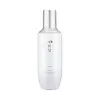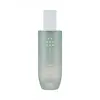What's inside
What's inside
 Key Ingredients
Key Ingredients

 Benefits
Benefits

 Concerns
Concerns

 Ingredients Side-by-side
Ingredients Side-by-side

Water
Skin ConditioningDipropylene Glycol
HumectantGlycerin
HumectantNiacinamide
SmoothingIsocetyl Myristate
EmollientDimethicone
Emollient1,2-Hexanediol
Skin ConditioningLactobacillus/Soybean Ferment Extract
Skin ConditioningHydrogenated Lecithin
EmulsifyingCyclopentasiloxane
EmollientPanthenol
Skin ConditioningHydrogenated Polyisobutene
EmollientSaccharomyces/Potato Extract Ferment Filtrate
HumectantSaccharomyces/Barley Seed Ferment Filtrate
HumectantSqualane
EmollientMacadamia Ternifolia Seed Oil
EmollientButyrospermum Parkii Butter
Skin ConditioningCeramide NP
Skin ConditioningPearl Powder
Panax Ginseng Root Extract
EmollientButylene Glycol
HumectantCnidium Officinale Root Extract
Skin ConditioningPoria Cocos Extract
Skin ConditioningPolygonum Multiflorum Root Extract
Skin ConditioningAngelica Gigas Root Extract
Skin ConditioningCuscuta Japonica Seed Extract
Skin ConditioningLycium Chinense Fruit Extract
AntioxidantPaeonia Lactiflora Extract
AstringentGinkgo Biloba Nut Extract
Skin ConditioningAtractylodes Macrocephala Root Extract
Skin ConditioningCornus Officinalis Fruit Extract
Skin ConditioningSchisandra Chinensis Fruit Extract
Skin ConditioningZiziphus Jujuba Fruit Extract
Skin ConditioningLonicera Japonica Flower Extract
Skin ConditioningBetaine
HumectantTrehalose
HumectantAdenosine
Skin ConditioningGlyceryl Stearate
EmollientPEG-100 Stearate
PEG-5 Glyceryl Stearate
EmulsifyingDimethiconol
EmollientDimethicone/PEG-10/15 Crosspolymer
Lauryl PEG-9 Polydimethylsiloxyethyl Dimethicone
Skin ConditioningDimethicone/Vinyl Dimethicone Crosspolymer
Skin ConditioningStearyl Alcohol
EmollientBehenic Acid
CleansingBehenyl Alcohol
EmollientStearic Acid
CleansingMyristic Acid
CleansingCarbomer
Emulsion StabilisingC14-22 Alcohols
Emulsion StabilisingTriethylhexanoin
MaskingArachidyl Glucoside
EmulsifyingCholesterol
EmollientTromethamine
BufferingTrisodium EDTA
Parfum
MaskingAlpha-Isomethyl Ionone
PerfumingCitronellol
PerfumingHexyl Cinnamal
PerfumingHydroxycitronellal
PerfumingLinalool
PerfumingWater, Dipropylene Glycol, Glycerin, Niacinamide, Isocetyl Myristate, Dimethicone, 1,2-Hexanediol, Lactobacillus/Soybean Ferment Extract, Hydrogenated Lecithin, Cyclopentasiloxane, Panthenol, Hydrogenated Polyisobutene, Saccharomyces/Potato Extract Ferment Filtrate, Saccharomyces/Barley Seed Ferment Filtrate, Squalane, Macadamia Ternifolia Seed Oil, Butyrospermum Parkii Butter, Ceramide NP, Pearl Powder, Panax Ginseng Root Extract, Butylene Glycol, Cnidium Officinale Root Extract, Poria Cocos Extract, Polygonum Multiflorum Root Extract, Angelica Gigas Root Extract, Cuscuta Japonica Seed Extract, Lycium Chinense Fruit Extract, Paeonia Lactiflora Extract, Ginkgo Biloba Nut Extract, Atractylodes Macrocephala Root Extract, Cornus Officinalis Fruit Extract, Schisandra Chinensis Fruit Extract, Ziziphus Jujuba Fruit Extract, Lonicera Japonica Flower Extract, Betaine, Trehalose, Adenosine, Glyceryl Stearate, PEG-100 Stearate, PEG-5 Glyceryl Stearate, Dimethiconol, Dimethicone/PEG-10/15 Crosspolymer, Lauryl PEG-9 Polydimethylsiloxyethyl Dimethicone, Dimethicone/Vinyl Dimethicone Crosspolymer, Stearyl Alcohol, Behenic Acid, Behenyl Alcohol, Stearic Acid, Myristic Acid, Carbomer, C14-22 Alcohols, Triethylhexanoin, Arachidyl Glucoside, Cholesterol, Tromethamine, Trisodium EDTA, Parfum, Alpha-Isomethyl Ionone, Citronellol, Hexyl Cinnamal, Hydroxycitronellal, Linalool
Water
Skin ConditioningCyclopentasiloxane
EmollientAlcohol Denat.
AntimicrobialDipropylene Glycol
HumectantGlycerin
HumectantPentaerythrityl Tetraethylhexanoate
Emollient1,2-Hexanediol
Skin ConditioningSorbitol
HumectantDimethicone
EmollientHydrogenated Polydecene
EmollientHouttuynia Cordata Extract
Skin ConditioningMelia Azadirachta Leaf Extract
Skin ConditioningNymphaea Alba Flower Extract
Skin ConditioningCI 77491
Cosmetic ColorantMelia Azadirachta Flower Extract
Skin ConditioningRoyal Jelly
Honey
HumectantArtemisia Capillaris Extract
Coccinia Indica Fruit Extract
Skin ConditioningMineral Salts
Skin ConditioningAloe Barbadensis Flower Extract
EmollientSolanum Melongena Fruit Extract
Skin ConditioningAloe Barbadensis Leaf Juice Powder
Skin ConditioningCarthamus Tinctorius Flower Extract
Skin ConditioningCarthamus Tinctorius Seed Extract
Skin ConditioningLycium Chinense Fruit Extract
AntioxidantPanax Ginseng Root Extract
EmollientSimmondsia Chinensis Seed Oil
EmollientCorallina Officinalis Extract
Skin ConditioningCurcuma Longa Root Extract
MaskingOcimum Sanctum Leaf Extract
Skin ConditioningButylene Glycol
HumectantSilica
AbrasiveMethyl Glucose Sesquistearate
EmollientAcrylates/C10-30 Alkyl Acrylate Crosspolymer
Emulsion StabilisingCI 77891
Cosmetic ColorantTromethamine
BufferingSynthetic Fluorphlogopite
PEG/PPG-17/6 Copolymer
SolventPEG-150
HumectantMethylpropanediol
SolventXanthan Gum
EmulsifyingTrisodium EDTA
Parfum
MaskingLimonene
PerfumingLinalool
PerfumingWater, Cyclopentasiloxane, Alcohol Denat., Dipropylene Glycol, Glycerin, Pentaerythrityl Tetraethylhexanoate, 1,2-Hexanediol, Sorbitol, Dimethicone, Hydrogenated Polydecene, Houttuynia Cordata Extract, Melia Azadirachta Leaf Extract, Nymphaea Alba Flower Extract, CI 77491, Melia Azadirachta Flower Extract, Royal Jelly, Honey, Artemisia Capillaris Extract, Coccinia Indica Fruit Extract, Mineral Salts, Aloe Barbadensis Flower Extract, Solanum Melongena Fruit Extract, Aloe Barbadensis Leaf Juice Powder, Carthamus Tinctorius Flower Extract, Carthamus Tinctorius Seed Extract, Lycium Chinense Fruit Extract, Panax Ginseng Root Extract, Simmondsia Chinensis Seed Oil, Corallina Officinalis Extract, Curcuma Longa Root Extract, Ocimum Sanctum Leaf Extract, Butylene Glycol, Silica, Methyl Glucose Sesquistearate, Acrylates/C10-30 Alkyl Acrylate Crosspolymer, CI 77891, Tromethamine, Synthetic Fluorphlogopite, PEG/PPG-17/6 Copolymer, PEG-150, Methylpropanediol, Xanthan Gum, Trisodium EDTA, Parfum, Limonene, Linalool
Ingredients Explained
These ingredients are found in both products.
Ingredients higher up in an ingredient list are typically present in a larger amount.
1,2-Hexanediol is a synthetic liquid and another multi-functional powerhouse.
It is a:
- Humectant, drawing moisture into the skin
- Emollient, helping to soften skin
- Solvent, dispersing and stabilizing formulas
- Preservative booster, enhancing the antimicrobial activity of other preservatives
Butylene Glycol (or BG) is used within cosmetic products for a few different reasons:
Overall, Butylene Glycol is a safe and well-rounded ingredient that works well with other ingredients.
Though this ingredient works well with most skin types, some people with sensitive skin may experience a reaction such as allergic rashes, closed comedones, or itchiness.
Learn more about Butylene GlycolCyclopentasiloxane, or D5, is a silicone used to improve texture of products and trap moisture.
D5 is considered lightweight and volatile. Volatile means it evaporates quickly after application. Once evaporated, D5 leaves a thin barrier that helps keep skin hydrated.
It is also an emollient. Emollients help soften the skin and prevent water loss. Silicones create a silky texture in products. D5 helps other ingredients become more spreadable.
Studies show D5 is safe to use in skincare products. We recommend speaking with a skincare professional if you have concerns.
Learn more about CyclopentasiloxaneDimethicone is a type of synthetic silicone created from natural materials such as quartz.
What it does:
Dimethicone comes in different viscosities:
Depending on the viscosity, dimethicone has different properties.
Ingredients lists don't always show which type is used, so we recommend reaching out to the brand if you have questions about the viscosity.
This ingredient is unlikely to cause irritation because it does not get absorbed into skin. However, people with silicone allergies should be careful about using this ingredient.
Note: Dimethicone may contribute to pilling. This is because it is not oil or water soluble, so pilling may occur when layered with products. When mixed with heavy oils in a formula, the outcome is also quite greasy.
Learn more about DimethiconeDipropylene Glycol is a synthetically created humectant, stabilizer, and solvent.
This ingredient helps:
Dipropylene glycol is technically an alcohol, but it belongs to the glycol family (often considered part of the ‘good’ alcohols). This means it is hydrating and gentle on skin unlike drying solvent alcohols like denatured alcohol.
As a masking agent, Dipropylene Glycol can be used to cover the smell of other ingredients. However, it does not have a scent.
Studies show Dipropylene Glycol is considered safe to use in skincare.
Learn more about Dipropylene GlycolGlycerin is already naturally found in your skin. It helps moisturize and protect your skin.
A study from 2016 found glycerin to be more effective as a humectant than AHAs and hyaluronic acid.
As a humectant, it helps the skin stay hydrated by pulling moisture to your skin. The low molecular weight of glycerin allows it to pull moisture into the deeper layers of your skin.
Hydrated skin improves your skin barrier; Your skin barrier helps protect against irritants and bacteria.
Glycerin has also been found to have antimicrobial and antiviral properties. Due to these properties, glycerin is often used in wound and burn treatments.
In cosmetics, glycerin is usually derived from plants such as soybean or palm. However, it can also be sourced from animals, such as tallow or animal fat.
This ingredient is organic, colorless, odorless, and non-toxic.
Glycerin is the name for this ingredient in American English. British English uses Glycerol/Glycerine.
Learn more about GlycerinLinalool is a fragrance and helps add scent to products. It's derived from common plants such as cinnamon, mint, citrus, and lavender.
Like Limonene, this ingredient oxidizes when exposed to air. Oxidized linalool can cause allergies and skin sensitivity.
This ingredient has a scent that is floral, spicy tropical, and citrus-like.
Learn more about LinaloolLycium Chinense Fruit Extract comes from a type of goji berry plant.
Goji berries contain polysaccharides, carotenoids and flavonoids. These give it antioxidant properties that protect your skin from free-radical molecules.
Polysaccharides help hydrate the top layer of skin due to its ability to mimic natural carbohydrates.
Learn more about Lycium Chinense Fruit ExtractGinseng root is a well-loved ingredient in Asian skincare for good reason. It hydrates the skin, soothes irritation, and helps even out skin tone.
In traditional East Asian medicine, ginseng has been used for centuries both as food and as a healing remedy, and modern research continues to confirm its skin benefits.
One of the standout features of ginseng is its ability to improve blood circulation and oxygen delivery to the skin, bringing a fresh supply of nutrients to support overall skin health. It also has antioxidant and anti-inflammatory properties. This helps to protect your skin against damage from UV exposure, pollution, and daily stress.
Additionally, studies suggest that ginseng may help reduce hyperpigmentation by inhibiting tyrosinase, the enzyme involved in melanin production.
There are different types of ginseng used in skincare, and while they all share core benefits, their potency can vary.
Most products use fresh or white ginseng because it’s more affordable. However, red ginseng, produced by steaming the root, contains higher levels of ginsenosides, which are compounds with proven anti-aging effects. These ginsenosides help reduce the appearance of wrinkles and improve skin elasticity.
Note: All forms of ginseng are listed simply as “Panax ginseng” in ingredient lists. We recommend reaching out to the brand if you have questions about which type of ginseng is used in their ingredients.
For general antioxidant benefits, any ginseng extract will do, but for wrinkle care or firmer skin, red or fermented ginseng is often more effective.
In short, ginseng is a powerhouse ingredient that supports hydration, radiance, and resilience.
Learn more about Panax Ginseng Root ExtractParfum is a catch-all term for an ingredient or more that is used to give a scent to products.
Also called "fragrance", this ingredient can be a blend of hundreds of chemicals or plant oils. This means every product with "fragrance" or "parfum" in the ingredients list is a different mixture.
For instance, Habanolide is a proprietary trade name for a specific aroma chemical. When used as a fragrance ingredient in cosmetics, most aroma chemicals fall under the broad labeling category of “FRAGRANCE” or “PARFUM” according to EU and US regulations.
The term 'parfum' or 'fragrance' is not regulated in many countries. In many cases, it is up to the brand to define this term.
For instance, many brands choose to label themselves as "fragrance-free" because they are not using synthetic fragrances. However, their products may still contain ingredients such as essential oils that are considered a fragrance by INCI standards.
One example is Calendula flower extract. Calendula is an essential oil that still imparts a scent or 'fragrance'.
Depending on the blend, the ingredients in the mixture can cause allergies and sensitivities on the skin. Some ingredients that are known EU allergens include linalool and citronellol.
Parfum can also be used to mask or cover an unpleasant scent.
The bottom line is: not all fragrances/parfum/ingredients are created equally. If you are worried about fragrances, we recommend taking a closer look at an ingredient. And of course, we always recommend speaking with a professional.
Learn more about ParfumWe don't have a description for Trisodium EDTA yet.
Tromethamine helps balance the pH and improve the texture of a product. It is synthetically created.
As an emulsifier, Tromethamine prevents oil and water ingredients from separating. This helps stabilize the product and elongate a product's shelf life. Tromethamine also makes a product thicker.
Tromethamine helps balance the pH level of a product. Normal pH level of skin is slightly acidic (~4.75-5.5). The acidity of our skin is maintained by our glands and skin biome. Being slightly acidic allows our skin to create an "acid mantle". This acid mantle is a thin barrier that protects our skin from bacteria and contaminants.
Oral Tromethanmine is an anti-inflammatory drug but plays the role of masking, adding fragrance, and/or balancing pH in skincare.
1,3-Propanediol, 2-amino-2-(hydroxymethyl)-
Learn more about TromethamineWater. It's the most common cosmetic ingredient of all. You'll usually see it at the top of ingredient lists, meaning that it makes up the largest part of the product.
So why is it so popular? Water most often acts as a solvent - this means that it helps dissolve other ingredients into the formulation.
You'll also recognize water as that liquid we all need to stay alive. If you see this, drink a glass of water. Stay hydrated!
Learn more about Water